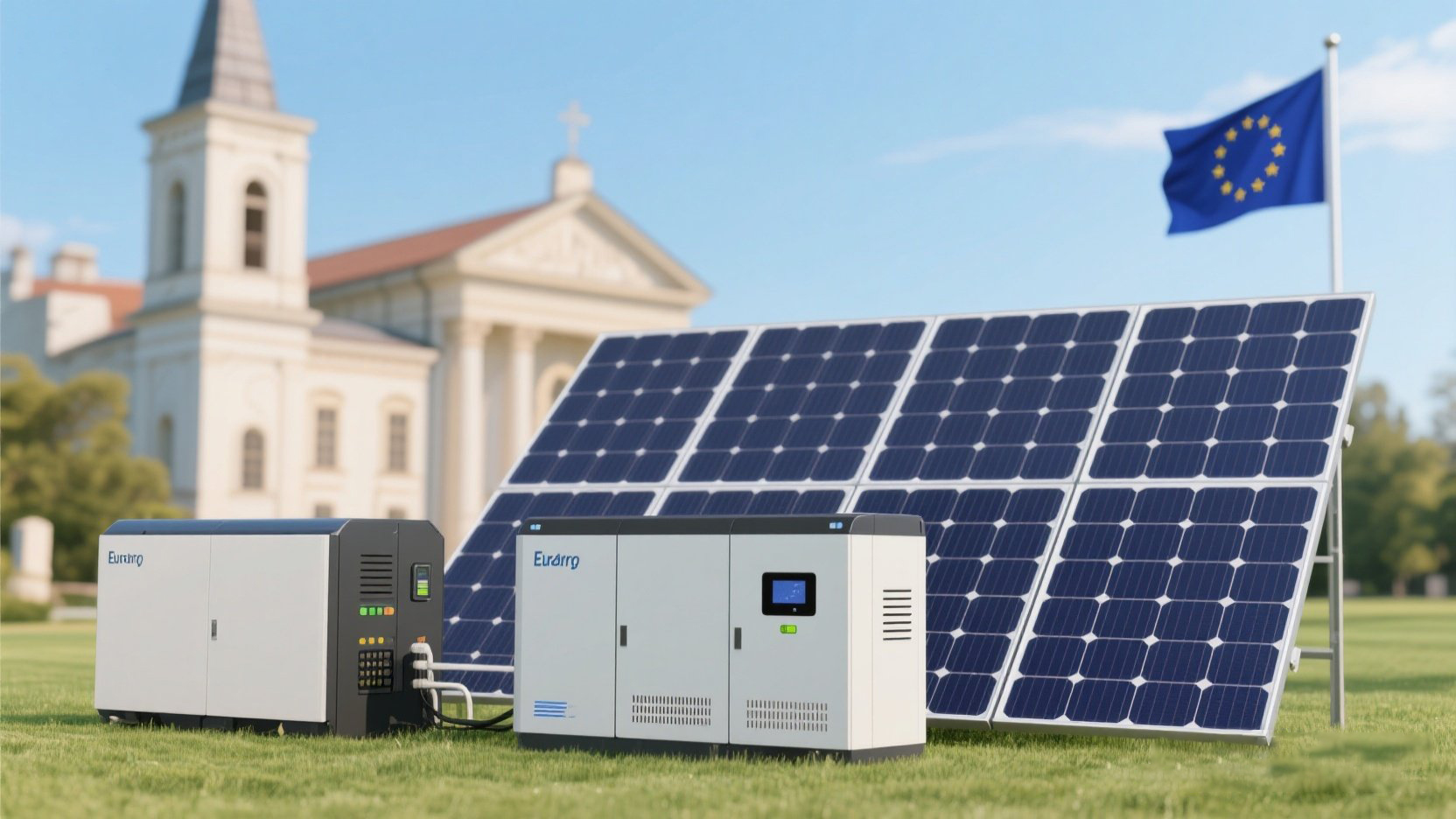EU Battery Storage Poised to Power the Renewable Energy Revolution

By synergizing renewable energy deployment with clean flexibility solutions, the EU can leverage abundant domestically produced wind and solar resources to reduce dependence on imported fossil fuels and achieve cost savings.
Table of Contents
Executive Summary
Flexibility Expansion Delivers Multiple Benefits
Renewables and Clean Flexibility: A Perfect Synergy
Urgent Need for Accelerated Clean Flexibility Deployment
Growing Hours of Wind and Solar Dominance
Solar-Battery Pairing Dynamics
Battery Opportunities Emerge Amid Solar Boom
Batteries Reduce Evening Fossil Fuel Reliance
Policy Recommendations
Supporting Materials
Methodology
Acknowledgements
Report Overview
This report analyzes the systemic benefits of integrating renewables with clean flexibility solutions, focusing on solar-battery synergy in the EU. Leveraging Ember’s hourly generation mix and electricity price datasets, the study demonstrates the strategic value of midday solar surplus and outlines how clean flexibility can reduce fossil fuel dependence while offering cost avoidance. Policy recommendations emphasize immediate battery storage deployment to meet decarbonization goals.
Key Findings
€9 Billion
By 2030, the EU could avoid €9 billion in gas costs through utilization of excess wind and solar power.
80%+
Nine EU countries recorded solar generation exceeding 80% of hourly demand between August 2023 and July 2024.
36 GWh
Additional 2 GW of battery storage in Germany could have displaced 36 GWh of fossil fuel generation in June 2024 alone, saving up to €2.5 million in fuel costs.
Executive Summary
Flexibility Expansion Delivers Multiple Benefits
Accelerating clean flexibility deployment enables 24/7 low-cost renewable power utilization across the EU. As renewable penetration grows rapidly, power systems require enhanced responsiveness. Current gaps in flexibility planning demand urgent policy interventions to unlock synergies between renewables and storage technologies.
Solar-battery pairing exemplifies this synergy. Years of solar expansion and volatile gas prices have amplified electricity price fluctuations, creating revenue opportunities for battery storage. By enabling midday solar capture and evening peak shaving, battery deployment can reduce fossil fuel reliance while supporting solar profitability.
Data Insights
01 €9 Billion Gas Cost Avoidance Potential
By 2030, EU wind and solar generation is projected to exceed demand by 183 TWh (equivalent to Poland’s annual consumption). Flexibility solutions like batteries and interconnectors could shift this surplus to displace fossil gas generation, avoiding €9 billion in annual gas procurement costs.
02 Solar Peaks Surpass 80% in Nine Countries
Between August 2023 and July 2024, the Netherlands and Greece achieved solar generation exceeding 100% of hourly demand, while seven other EU countries saw solar peaks above 80%.
03 Germany’s Battery Storage Demonstration
Adding 2 GW of battery capacity (+20% to existing infrastructure) in June 2024 would have displaced 36 GWh of fossil generation during evening peaks. This translates to €1.3 million in hard coal cost savings or €2.5 million in gas cost avoidance.
Expert Perspective
"Maximizing low-cost renewable utilization is imperative. As solar capacity soars, batteries will ensure surplus power availability across all hours. While EU renewables growth has been rapid, clean flexibility deployment lags. Accelerating this transition is critical for consumers and businesses to reap the benefits of reduced fossil dependence."
Dr. Beatrice Petrovich, Senior Energy & Climate Analyst, Ember
Technical Analysis
Renewables and Clean Flexibility: A Perfect Synergy
Grid interconnections, demand-side flexibility, pumped hydro, and battery storage are essential for balancing variable wind and solar generation. These solutions enable temporal and spatial power redistribution, optimizing grid stability.
Urgent Need for Accelerated Clean Flexibility Deployment
Under REPowerEU targets, the EU aims to:
Triple solar capacity
Double wind capacity by 2030
Achieve 66% renewable share in annual generation
Ember modeling projects:
49% hourly average wind/solar contribution by 2030 (vs. 27% in 2023)
4% of hours with renewables exceeding total demand (up from 0.1% in 2023)
35% of hours with renewables covering >50% of demand (vs. 3% in 2023)
Expanding Renewable Dominance
In H1 2024:
Wind and solar generated 30% of EU electricity
Fossil fuels fell to 27%
Key trends (August 2023–July 2024):
15 EU countries experienced >80% wind/solar hourly penetration
Germany: 36% of hours powered by renewables (up from 26%)
Netherlands: 44% renewable penetration (up from 31%)
EU-wide wind/solar hourly contribution ranged 6%-64%
System Inflexibility Constraints
Summer 2024 observations:
Midday renewables (20-60% penetration) reduced fossil reliance
Evening peaks remained dependent on gas/coal
Germany's fossil share:
1 PM: Dropped from 36% (2021) to 20% (2024)
8 PM: Declined only marginally (47% → 44%)
Key limitations:
Inflexible baseload plants
Conservative grid practices (e.g., Poland’s 55-60% renewable curtailment threshold)
Battery Storage Breakthroughs
Solar Boom Unlocks Battery Opportunities
Dramatic cost reductions driven by EV industry advancements
Grid-scale and behind-the-meter deployment now viable
German studies confirm solar-battery hybrids outcompete coal/gas on LCOE
Current EU battery specs:
Average duration: 1.5 hours
Emerging systems: 2-4 hour duration
Price Volatility Strengthens Storage Economics
2024 intraday price spreads:
| Country | 2023 Spread (€/MWh) | 2024 Spread (€/MWh) |
|---|---|---|
| Greece | 71 | 262 |
| Hungary | 102 | 397 |
Battery benefits:
Capitalize on arbitrage opportunities
Flatten peak prices
Support solar capture rates
Germany’s Storage Leadership
Holds 46% of EU battery capacity (9.5 GW by June 2024)
Projection: 11.4 GW by end-2024
Simulation: 2 GW added storage could eliminate hard coal generation for 12 evening hours in June 2024
Policy Recommendations
Remove Barriers to Renewable-Storage Integration
Streamline grid connection rules for co-located solar-battery systems
Include storage in renewable acceleration zone planning
Publish granular grid hosting capacity data
Advance National Flexibility Strategies via NECPs
Finalize NECPs with explicit storage/demand-side flexibility targets
Implement EU storage guidelines (e.g., eliminate double grid fee charging)
Introduce flexibility support schemes under Electricity Market Design reforms
Optimize Market Access for Flexibility Resources
Allow battery participation in capacity markets and ancillary services
Design carbon-adjusted capacity mechanisms
Enhance EU System Planning Transparency
Improve modeling of fossil flexibility phase-out pathways
Mandate public disclosure of flexibility deployment data
Develop EU-Wide Clean Flexibility Strategy
Integrate storage, smart electrification, and demand-side solutions into Clean Industrial Deal
Promote west-facing solar panels to align generation with evening demand
Methodology
Hourly generation data: Synthesized from ENTSO-E, national grid operators, and Eurostat
2030 surplus estimation: Based on 2009 climate year profiles scaled to NECP targets
German storage simulation: Assumed 1.9 GW/1.6-hour batteries displacing evening fossil generation




